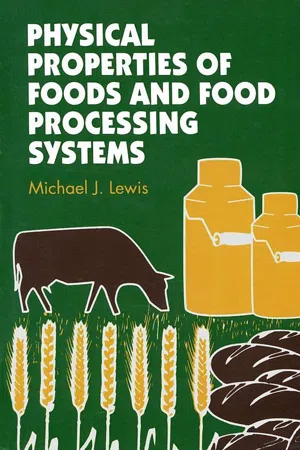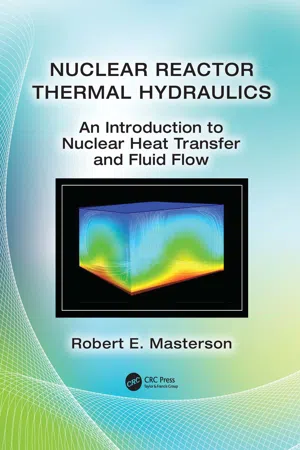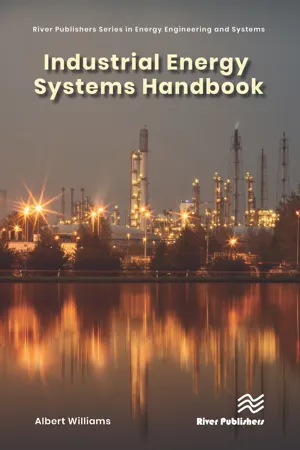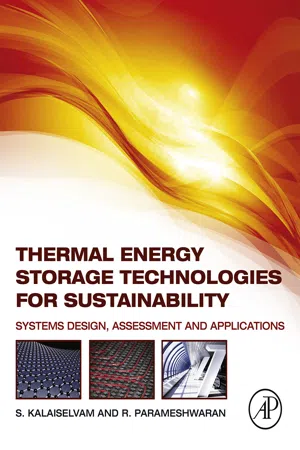Physics
Specific Latent Heat
Specific latent heat refers to the amount of heat energy required to change the state of a unit mass of a substance without a change in temperature. It is specific to each substance and is typically expressed in joules per kilogram. When a substance undergoes a phase change, such as from solid to liquid or liquid to gas, specific latent heat is involved in the process.
Written by Perlego with AI-assistance
Related key terms
Related key terms
1 of 4
Related key terms
1 of 3
6 Key excerpts on "Specific Latent Heat"
- eBook - ePub
- W. Bolton(Author)
- 2015(Publication Date)
- Routledge(Publisher)
latent heat.The Specific Latent Heat L of a material is defined as the amount of heat needed to change the phase of 1 kg of the material without any change in temperature and has the unit J/kg. Thus the heat transfer Q needed to change the phase of m kg of a material is:Q = mLThe term Specific Latent Heat of fusion is used when the change of phase is from solid to liquid and the term Specific Latent Heat of vaporisation for the change from liquid to vapour. Typical values are: Specific Latent Heat of fusion for water 335 kJ/kg, aluminium 387 kJ/kg, and iron 268 kJ/kg; Specific Latent Heat of vaporisation for water 2257 kJ/kg, ethyl alcohol 857 kJ/kg.ExampleHow much heat is required to change 1.2 kg of water at 20°C to steam at 100°C? The specific heat capacity of water in this temperature range is 4200 J kg−1 K−1 and the Specific Latent Heat at 100°C for liquid to vapour is 2257 kJ/kg.To raise the water from 20°C to 100°C: Q = mcΔt = 1.2 x 4200 x (100 - 20) = 4.0 x 105 J. To change water from liquid to vapour at 100°C: Q = mL = 1.2 x 2257 x 103 = 27.1 x 105 J. The total heat required is thus 4.0 x 105 + 27.1 x 105 = 31.1 x 105 J.8.3 Expansion
Solids expand when their temperature is increased. The amount by which a length of solid expands depends on the change in temperature, the original length of the material and the material concerned. The coefficient of linear expansion α (or linear expansitivity ) is defined as:The coefficient has the unit of /°C or /K. If L0 is the length at temperature θ and L0 the θ - M J Lewis(Author)
- 1990(Publication Date)
- Woodhead Publishing(Publisher)
8Sensible and latent heat changes
8.1 INTRODUCTION
The properties to be discussed in this chapter include specific heat, latent heat and specific enthalpy.These properties play an important role in heat transfer problems when heating or cooling foods. It is necessary to know the specific heat to determine the quantity of energy that needs to be added or removed. This will give an indication of the energy costs involved and in a continuous process will have an influence on the size of the equipment.Latent heat values, which are associated with phase changes, play an important role in freezing, crystallization, evaporation and dehydration processes.8.2 SPECIFIC HEAT
The specific heat of a material is a measure of the amount of energy required to raise unit mass by unit temperature rise. As mentioned in Chapter 7 , specific heat is temperature dependent. However, for the purpose of many engineering calculations, these variations are small and an average specific heat value is used for the temperature range considered.The units of specific heat are kilojoules per kilogram per kelvin (kJ kg−1 K−1 ), kilocalories per kilogram (kcal kg−1 K−1 ) or British thermal units per pound per degree Fahrenheit (Btu lb−1 degF−1 ). From the definitions of the different thermal units, the specific heat of water in the respective units is1 .0. kcal kg −1K −1or 4.18 kJ kg−1K −1or 1 Btu lb−1degF −1In a batch heating or cooling process, the amount of heat (energy) Q required or removed is given byIn a continuous process, the rate of heat transfer is given byQ = mass × average specific heat × temperature change= MC Δ TJ or kcal or BtuQ / t = mass flow rate × specific heat × temperature rangeThe units of Q /t are joules per second (J s−1 ), i.e. watts (W), or British thermal units per hour (Btu h−1 ). This is often termed the heating or cooling duty of the heat exchanger. If it is felt that this is not a sufficiently accurate procedure, the total energy requirement can be obtained by graphical integration. Specific heat is plotted against temperature; the total heat required to raise unit mass from T 1 to T 2 is given by ∫cp dTor the area under the curve (Fig. 8.1 ) This should, in most cases, be not too far removed from the value obtained by selecting a specific heat value at the average temperature (T 1 + T 2 )/2. If the relationship between the specific heat and temperature is known in terms of temperature, then the integral ∫cpdT can be evaluated directly, (see section 8.4- eBook - ePub
- R.A. Edwards(Author)
- 2014(Publication Date)
- Pergamon(Publisher)
CHAPTER 7The Measurement of Heat Quantity
Publisher Summary
This chapter describes different methods of measurement of heat quantity. The specific heat of a substance at any temperature is defined as the quantity of heat required to raise the temperature of unit mass of that substance by one degree. The thermal capacity of a body or mass of material is the quantity of heat required to raise the temperature of that body or mass of material by one degree. The quantity of heat required to convert unit mass of the solid into liquid without change of temperature is called its latent heat of fusion. The latent heat of vaporization, or evaporation, is the quantity of heat required to convert unit mass of liquid into vapor without change of temperature, that is, at the boiling point. The latent heat of fusion of ice can be measured by a simple method of mixtures. An electrical method could be used using a calorimeter similar to that used for the electrical method for the determination of the specific heats of solids. The calorific value of a fuel is the quantity of heat liberated as a result of the complete combustion of unit mass of the fuel. A gas calorimeter is used to measure the calorific value of gas fuels or of liquid fuels, which easily vaporize.7.1 Specific Heat
The specific heat of a substance at any temperature is defined as the quantity of heat required to raise the temperature of unit mass of that substance by one degree . For example, if an infinitesimal quantity of heat dH is required to raise a mass m of a substance from a temperature θ to a temperature θ + dθ , then the specific heat s of the substance is defined as(7.1)Modern practice is to express specific heat in joules per gram per degC (J g−1 degC−1 ) or alternatively in joules per kilogram per degC (J kg−1 degC−1 ). Over quite considerable ranges of temperature the value of s for a material often varies only slightly, but in accurate work its variation may be regarded as significant. If s may be considered constant over a finite change Δθ in temperature, then the heat ΔH gained or lost by a mass m of the substance in rising or falling through the temperature range Δθ - eBook - ePub
Nuclear Reactor Thermal Hydraulics
An Introduction to Nuclear Heat Transfer and Fluid Flow
- Robert E. Masterson(Author)
- 2019(Publication Date)
- CRC Press(Publisher)
the value of the specific heat depends on whether the heat is being added to a material at a constant temperature or constant pressure. Ordinarily, the difference in the energy storage capacity at constant pressure and constant temperature is small, but when it comes to gases and gas-cooled reactors, this conceptual difference can be significant. Consequently, classical thermodynamics defines two separate types of specific heats:- The specific heat at constant volume Cv
- The specific heat at constant pressure Cp
7.37 Specific Heat at Constant Volume
The specific heat at constant volume Cv is defined as the amount of energy required to raise the temperature of a unit mass of a substance by one degree while the volume of the substance remains unchanged (V = constant). This temperature increase can be measured in °F, °C, or °K. In the SI unit system, the temperature change is expressed in °K. Because the volume of a material is not allowed to change in this process, the substance to which heat is being added cannot do any external work on its environment. Because of this, the value of Cv is sometimes used to represent the internal energy u. Both Cv and u are usually associated with solids (which only expand or contract slightly) rather than liquids or gases (which can expand or contract a great deal more). Liquids and gases, which can do a considerable amount of external work when their volume changes, are described by another thermodynamic property called the specific heat at constant pressure Cp . Not surprisingly, the specific heat at constant pressure is more closely related to the specific enthalpy h than it is to the specific internal energy u.7.38 Specific Heat at Constant Pressure
The specific heat at constant pressure Cp is defined as the amount of heat required to raise the temperature of a unit mass of a substance by 1° while the pressure of the substance is held constant. The specific heat at constant pressure is always greater than the specific heat at constant volume - eBook - ePub
- A.E. Williams(Author)
- 2023(Publication Date)
- River Publishers(Publisher)
Thermal energy is described as internal energy stored in a system that is responsible for its temperature. If the temperature of the object changes, the thermal energy input is determined as follows:Q t = m × C p × Δ TWhen there is a phase change in the system, ∆T is zero, but ∆Qt is not zero, therefore the specific heat capacity (∆Qt/m·∆T) will be undefined. However, the total amount of thermal energy needed to cause a phase change per kilogram of material is still important. This energy needed for the phase change is known as latent energy and is calculated as follows:When thermal energy is transferred from one object/surface to another (by conduction, convection and radiation) it is calculated using:L a t e n t e n e r g y =T h e r m a l e n e r g y i n p u tM a s sh =Q tmo rQ t = m × Δ h- Conduction: q = −k d td x
- Convection: q = hc × A × dT
- Radiation: q = σ × T4 × A
- For objects other than ideal blackbodies the Stefan-Boltzmann Law can be expressed as: q = ε × σ × T4 × A
5.7.1 Heat loss calculations
The process of calculating heat loss in buildings and rooms is described next. The following information is needed:- The temperature inside the building or room;
- The ambient (outside temperature) and temperatures of surrounding spaces;
- The direct heat loss from the overall surface area of the structure; and
- Whether the heat loss is through natural or mechanical ventilation.
The difference in temperature between the indoor and outdoor air causes a transmission of heat energy through the solid components of the building envelope. The materials used in the building envelope can have a significant impact on the amount of energy required to maintain a suitable environment and temperature within the building. For example, glass or steel building walls are a major source of heat loss in the winter and heat gain in the summer and walls with masonry, insulation and cladding have more thickness and much higher insulating capabilities and, therefore, much lower heat loss and heat gain. - eBook - ePub
Thermal Energy Storage Technologies for Sustainability
Systems Design, Assessment and Applications
- S. Kalaiselvam, R. Parameshwaran(Authors)
- 2014(Publication Date)
- Academic Press(Publisher)
Fig. 5.1 .Figure 5.1 The schematic representation of the heat gains in indoor environment.5.2 Physics of LTES
The incorporation of LTES systems in buildings largely depends on the phase change characteristics of the heat storage material being considered. The inherent phenomenon that drives the operational performance of the heat storage materials is their ability to undergo phase transformation at isothermal conditions. That is, when such materials are cooled down to below their melting temperature, they would start to freeze (or crystallize) at constant temperature.Similar is the case for the fusion of such materials while they are subjected to temperatures higher than their melting point. The freezing or melting of the heat storage materials would characterize their phase transformation, wherein the thermal energy is stored or released in the form of differential latent heat transfer.For a better understanding, the phase change phenomenon of a thermal storage material is shown in Fig. 5.2 . It is clearly seen that the phase transition is comprised of three stages each in freezing and melting processes. In freezing, the temperature of the thermal storage material initially decreases (process A-B), which signifies the sensible cooling of the material (in liquid state) with respect to the surrounding heat transfer (cooling) medium (HTM).Figure 5.2 Heat storage and release processes of the PCM.Upon continuous cooling (extraction of heat energy), the material undergoes liquid-solid phase change (process B-C), which takes place at the constant temperature. At this condition, the thermal energy (cooling energy) from the HTM is effectively transferred to the thermal storage material in the form of latent heat. The temperature again starts to decline further (process C-D), which is due to the sensible heat transfer occurring in the solid material with regard to the HTM temperature. Once the thermal equilibrium is established between the HTM and the thermal storage material, the temperature of the system remains unaltered.
Index pages curate the most relevant extracts from our library of academic textbooks. They’ve been created using an in-house natural language model (NLM), each adding context and meaning to key research topics.
Explore more topic indexes
Explore more topic indexes
1 of 6
Explore more topic indexes
1 of 4





